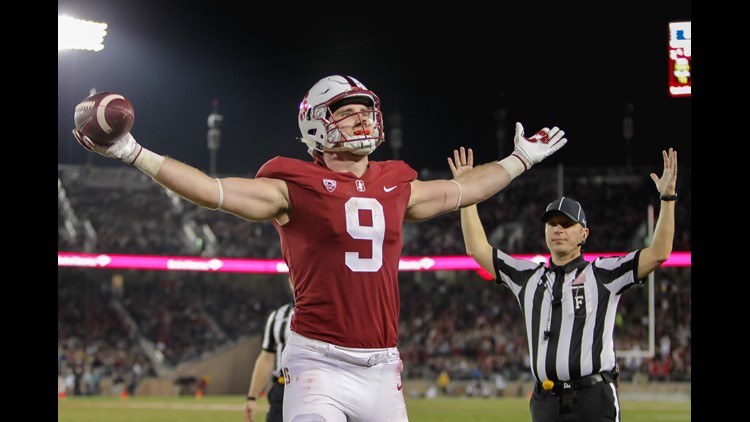When the Houston Texans signed C.J. Fiedorowicz to a three-year extension in April of 2017, the team’s tight end situation appeared to be sorted out for the foreseeable future. Just a month prior, Ryan Griffin had re-signed with the team, and the duo was coming off of a career year where they had combined for 104 catches and in excess of 1000 yards.
The pair handled its duties as blockers, and with Stephen Anderson also on the roster as a pass-catching big slot with upside and all three 27 or younger, Houston seemed set for the 2017 season and beyond.
Nearly a year later and the Texans are in a quandary. Fiedorowicz has unfortunately retired and Griffin spent the latter half of last season on injured reserve; the plight of the team’s tight ends showing how devastating concussions can be. Griffin will be back in 2018 but has neither the receiving ability nor reliability as a blocker to be a true No. 1 tight end, and Anderson’s size handicaps him such that he will never be a long-term in-line option. The team has not (as of the time of writing) signed a free agent to fill the vacancy at the top of their tight end depth chart, and it appears they will turn to the NFL Draft to secure Fiedorowicz’ replacement.
This is not a particularly strong class at tight end. Five tight ends came off the board in the first 45 picks last year, and there is a legitimate chance that not a single player at the position is drafted in the same span this year. All the top prospects have their warts, and analysts rank them very differently. Mike Gesicki may have separated himself with his freakish combine, but his deficiencies as a blocker mean his role will be limited early in the NFL. Tyler Conklin, Mark Andrews, Hayden Hurst, Ian Thomas and Dallas Goedert are all sighted atop draft boards, but each seems to have a nagging question mark that stops them from being a consensus top-50 player.
For the Texans, this is not necessarily a bad thing. The team is not slated to pick until the top of the third round, and many of the players listed above will likely fall to that spot given their respective flaws. They will not have to pay a premium price to secure their future at the position and should be able to secure a tight-end who can contribute with one of their first three picks. That player should be Dalton Schultz.
There is certainly interest from Houston: Schultz dined with the Texans last week the night before Schultz’ pro day at Stanford, and is believed to have worked out privately for tight ends coach Tim Kelly. A junior entry into the 2018 NFL Draft, Schultz will not turn 22 until July and is one of the youngest players at his position in the class.
Schultz produced unspectacular receiving numbers with the Cardinal. David Shaw’s offense is run-heavy, and Stanford suffered with quarterback inconsistency throughout Schultz’ time with the team. Averaging under two catches per game throughout, Schultz’ sophomore and junior year yardage totals combined fail to eclipse 450 yards.
But this is not to say he is a bad pass-catcher. His tape shows strong hands and an ability to get open as a route-runner. Schultz tested relatively well at the NFL Scouting Combine, with a particularly good time in the three-cone – his agility flashes on tape even in limited opportunities as a receiver. There is sufficient upside to be tapped and cultivated, particularly given his youth.
Where Schultz will make his money initially in the NFL is as an inline blocker, and along with Notre Dame’s Durham Smythe he stands head and shoulders above the rest of the class. Stanford utilized him in-line on the majority of his snaps, and he often functioned as a pseudo-lineman, generating great push in the run game.
Far from a domineering presence at 244 pounds (13th percentile among tight ends at the Combine), Schultz is technically sound, with intelligent and well-coached hand-placement and sound footwork. He is strong at the point of attack and is able to drive and finish against edge defenders. Schultz was key in helping both Christian McCaffrey and Bryce Love excel for the Cardinal, and earned first-team All-Pac 12 honors in 2017 largely due to his work opening holes for the latter, who finished second in the FBS with 2,118 yards on the ground.
The Texans can look to replace Fiedorowicz in one of two ways: get another dynamic weapon for Deshaun Watson, or target a strong blocker to aid the run game. There is no tight end, at least in my opinion, in this class who offers both immediately in the NFL. Schultz has enough athleticism and route-running nous to become a more viable receiving option in the future, though, and at the very least would already be the best blocking tight end on the roster. He does not necessarily need to contribute right away as a pass-catcher: The Texans have a well-stocked receiver room, and Stephen Anderson can continue in his third-down role.
Stanford has become a production line for NFL tight ends, and coach Morgan Turner has seen four of his tutees (Coby Fleener, Zach Ertz, Levine Toilolo and Austin Hooper) go on to contribute in the NFL: Dalton Schultz is ready to do the same, and the Houston Texans should certainly target him in the 2018 NFL Draft.



